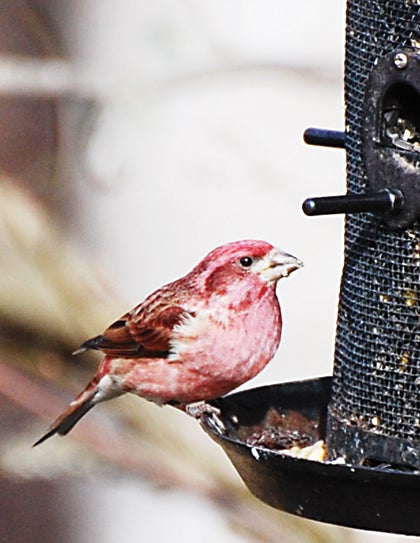Great Backyard Bird Count reveals details on bird species locations, movement
Published 9:12 am Thursday, February 18, 2016

One annual event unites bird watchers around the world for the shared purpose of species mapping: The Great Backyard Bird Count (GBBC).
The count is facilitated by the Cornell Lab of Ornithology, the Audubon Society and Bird Studies Canada to do what no single scientist or team of scientists could do: track the complex movement patterns of species globally. It also provides data which can be used to study how birds are affected by environmental changes. It may also reveal expanding and shrinking ranges of a species or places where birds are adapting to urbanization.
The El Niño weather current which warms Pacific waters every few years has led to temperatures matching record highs and was predicted to have noticeable effects on bird distribution, according to a GBBC press release.
The most recent powerful El Niño took place in the years 1997-98, when the GBBC was first launched in the U.S. and Canada. In 2013, the count went global, and continued to take place for four days in mid-February.
“The GBBC was launched in February 1998 and was pretty small at first. This will be the first time we’ll have tens of thousands of people doing the count during a whopper El Niño,” said Cornell Lab of Ornithology’s Marshall Iliff, a leader of the eBird program which collects worldwide bird counts year-round and also provides the backbone for the GBBC.
Bird clubs and individuals around the globe submit data year-round to the eBird database, which now facilitates the GBBC.
This year’s count yielded results from 138 countries and every continent.
In Carter County alone, 43 birders counted 53 species including one great horned owl, belted kingfisher and hooded merganser as well as some more common species like hundreds of American crows and numerous European starlings, American Robin, mallards and mourning doves.
It revealed 141 species in Tennessee, 654 species in the U.S. and 5,205 in the world from a total of 144,825 checklists submitted.
This and other counts reveal trends locally and globally.
Rick Knight, statistician with the Elizabethton Bird Club, said he has observed declining populations of bob white quail, shrikes and some others, which he said is likely due to habitat loss.
In order to accommodate these species, he recommended planting native fruit trees in yards and creating or installing some sort of water feature — whether it is a bird bath, pond or fountain. Nesting boxes are also beneficial for housing species like blue birds and chickadees, he said.
Some species Knight noted that are increasing in numbers include Cooper’s hawks and bald eagles. The eagles may be in response to a release a few years ago, and he said the hawks may be adapting to human-influenced habitats, as well as decreased poaching.
These observations are critical for wildlife management, Knight said.
“Citizen-science projects like the Great Backyard Bird Count are springing up all over the world,” says Jon McCracken, national program manager at Bird Studies Canada. “More and more, scientists are relying on observations from the public to help them gather data at a scale they could never achieve before. The GBBC is a great way to get your feet wet: you can count birds for as little as 15 minutes on one day or watch for many hours each day at multiple locations–you choose your level of involvement.”
Anyone can catalog observations, but because of this, experts do analyze the results. Knight said occasionally, birders are required to substantiate their claims.
For years, Carter County birder and photographer Jean Potter recorded bufflehead ducks on Wilbur Lake in unusually large concentrations and submitted the data to GBBC. She was questioned the first time, and continued to report them in subsequent years. This Winter, she and her husband Brookie counted 112.
“They would not count them,” she recalled of the first year. “I had to prove that we had that many on our lake. One of the benefits of the count is that it reveals some species are in areas that we did not know were here.”
Especially this year, with variable weather patterns and increasing urbanization, birders anticipate more unusual sightings.
The most unusual bird Potter referenced from this count in Carter and its four surrounding counties was the snow goose, seen by Bryan Stevens at Fishery Park in Unicoi County.
Some species she noticed this year which she called “eruptive species” include the purple finch and pine siskins, which only come down during certain winters in relation to their food supplies.
In total, Potter counted 14 species in her backyard alone this year in just a half an hour watching from her kitchen window.
“Anybody can join in the count,” she said, noting how she still called Cardinals “red birds” when she went on her first count. “We have people quite often that know hardly anything about birds, but they join us on counts, and we teach them as we go.”
The Herndon Chapter of the Tennessee Ornithological Society, founded in 1944 by Dr. Lee R. Herndon and his wife, Lois Herndon, sponsors activities annually including a Christmas Bird Count in Elizabethton and Roan Mountain as well as counts in the Spring, Summer and Fall. The club meets on the second Tuesday of the month in the lower level of Milligan College’s Science Building at 7 p.m. Visitors from Carter County and surrounding counties are welcome to join with no prior experience. For more information visit the Facebook page Elizabethton Bird Club.
Participating in the bird count is an opportunity to all with a reliable field guide. To review data from this year’s count or to learn more about how to participate next February, visit this link.





